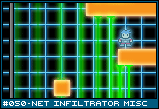|
Mechanic #050 - Net Infiltrator Misc |

Category: Comp-grid | Posted: 06/27/07
Three new additions to the Net Infiltrator concept. |
![[netmisc1.png]](set03/img/entry050-netmisc1.png)
On some servers, there will be periodic virus scans. During these scans, a laser will scan from one direction to the opposite one, checking the validity of each program it finds. Sometimes, it will go left to right, or right to left, top to bottom, or bottom to top. If it finds a program that does not belong there (such as one of your programs that you've not disguised), it will alert the security daemon, which will then start spawning enemy agents to attack you.
The scanner bar can be interrupted by obstacles in the field. In this illustration, notice that the beam is stopped by the orange walls. If you stand between the two walls, the beam cannot hit you. Unfortunately, the next time the scan runs, it might go up to down, so that location will not be absolutely safe.
Some programs can interrupt the scan (let's say corrupt data blocks or something). When the scan hits that block, it is temporarily disabled and will resume mid-scan a few squares later. However, hitting these blocks, while obscuring you if you are nearby, may cause additional negative effects, like causing damage to nearby programs or perhaps alerting a repair daemon who will arrive to repair the block (and potentially add to your troubles).
![[netmisc2.png]](set03/img/entry050-netmisc2.png)
The files that you have to access are protected by a small grid of programs. At the most basic level, you must break through this grid, block by block, at least enough to access the file directly.
Each of these blocks is a different type of program and offer different types of protection at different levels. For instance, a cipher lv3 block would require a cryptanalysis of level 3 or higher to break (you could use less programs of the same type, but they take longer and risk tripping an alarm). You do not know what a block is until you scan it, but you can scan more than one block at a time.
Each block connected to the file (either by touching the file directly or through touching blocks that are) contributes some sort of cummulative protection. For instance, a cipher lock encrypts the file. You can still copy the file, but you can't read it (you can always break the encryption later). There are three different file access locks: read, write, and delete. Each one individually does not prevent the that process from happening, but slows it down. So if a file has three write-blocks, changing the file will require three times as long as if it had zero blocks. If you can break enough blocks to have two points of access to the file, you can put two agents on it, working on it twice as fast. It's all about resources - you versus them versus time.
![[netmisc3.png]](set03/img/entry050-netmisc3.png)
A daemon is a type of program that is not limited to a single server. They can move around at will between them and have some sort of global effect on the server they are currently residing in. For instance, a virus scanner daemon might move between the different servers and scan them periodically (see above). A security daemon may cause enemy agent programs to spawn when an alarm goes off. A repair daemon might spawn repair agents that will fix bad sectors, and so on.
When an agent is on a server, it is usually represented by an agent program. This means you can find it and destroy it, destroying the agent completely. However, they tend to be quite powerful, and destroying one is a good way to make all the red flags go up and get you in deep doo-doo. Instead, they represent a roving threat - something to keep track of and avoid when possible.
However, you can use them to your advantage. For instance. there may be a server with some bad sectors in it blocking your path, but are hidden from view of the scanners. By purposely creating a bad sector where the scanners CAN see, the repair daemon will be dispatched to the server, where the repair agents will repair ALL broken sectors.
Another example. A security agent is blocking the path to the second half of the server farm - the half you want to be on. So you create a diversion by spawning a suspicious program over in a distant server. The virus scanner will find it and alert the security daemon of its presence. The security daemon will then move from the server it currently resides on to the suspicious server, allowing you passage. If you really needed some time, you could corrupt the data lines between servers, stranding the daemon process there until one of the less threatening daemons can repair it. All the alarms in the world won't hurt you if the entire security force is blocked off. Go be a bad guy.
|